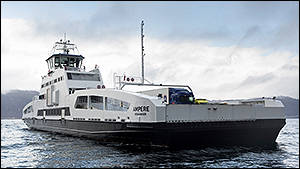Setting a Course for Carbon-Free Shipping
3. 6. 2015 | Siemens | www.siemens.com
In conjunction with Fjellstrand, a Norwegian shipyard, Siemens has developed the technology for the world’s first electrically-powered car ferry. The fact that the ferry, which entered service in early 2015, causes no carbon dioxide emissions is in part due to Norway's electricity mix.
As silently as a crocodile, the white giant approaches the shore. It opens its “mouth,” which is several meters across. Suddenly the silence is broken by the roar of engines as a stream of trucks and people emerge from the opening. Odd Moen, an engineer who is responsible for ship solution sales at Siemens Norway, smiles. His vision of an electrically-powered ferry sailing across Norway’s fjords just became a reality. Making hardly a sound and producing absolutely no emissions, it's the first and only ferry of its kind in the world.
A Century of Battery-Powered Service
"For more than 100 years, there have been battery-powered submarines that run solely on electricity,” says Moen. “That got us wondering why we couldn’t bring such a drive system concept to the surface, so to speak.” Experts began to work on developing this idea as early as 1999, but the technology needed was still too new for the market at that point, Moen recalls. Since then, however, technologies have improved, and lifecycle assessment issues have become more important.
Five years ago the Ministry launched a competition to develop the most environmentally friendly ferry. Diesel-operated ships continue to serve this connection, but the concession license expires in 2015. “We got together with the Fjellstrand shipyard and the ship owner Norled and developed an old idea further,” Moen explains. “We pooled our expertise – Fjellstrand’s knowledge of energy-efficient shipbuilding and Siemens’ electric propulsion expertise.” The result is a sophisticated concept that’s unparalleled anywhere in the world and unrivaled in terms of environmental compatibility. “That’s what ultimately convinced the Ministry officials,” says Moen.

The cooperative effort led to the creation of a fully electric ferry that travels across the fjord 34 times per day, with each trip requiring around 20 minutes to make the six-kilometer crossing. The ferry, which is 80 meters long, is driven by two electric motors, each with an output of 450 kilowatts. Both are powered by lithium-ion batteries. The batteries have a combined capacity of 1,000 kilowatt-hours (kWh), which is enough to make a few trips between the two fjord communities. After that the batteries need to be recharged.
Fjellstrand and Siemens engineers have come up with a simple idea to address the batteries’ range problem. “We want to recharge the batteries at the docks after each trip,” Moen explains. Still, this will give the ferry operator only ten minutes for recharging while passengers and vehicles disembark. The problem is that the power grid in the region is relatively weak, as it was designed to provide electricity only to small villages. “Briefly consuming so much energy from the medium-voltage system to recharge the ferry batteries would cause the washing machines in all the houses in the area to stop running. Obviously we can’t do that to the residents here,” Moen explains.
Green Power Mix
Siemens’ experts therefore installed one lithium-ion battery at each pier to serve as a buffer. The 260-kWh unit supplies electricity to the ferry while it waits. Afterward, the battery slowly recoupes all of this energy from the grid until the ship comes back again to drop off passengers and recharge. The charging stations are housed in a small building about the size of a newsstand. The ship’s batteries are recharged directly from the grid at night after the ferry stops operating. This solution is both simple and ingenious. “Under the prevailing conditions, it was the only feasible way of building and operating a battery-powered ferry,” says Moen. “Otherwise we would have had to expand the entire grid, and that would not have been possible due to the high costs of such a project.”
It isn’t just its drive system that makes the new ferry so environmentally friendly. Its electric motors are of course virtually silent and don’t burn any fossil fuels. They also don’t produce any pollutants. By contrast, a conventional ferry traveling the same route consumes around one million liters of diesel fuel and emits 2,680 tons of carbon dioxide and 37 tons of nitrogen oxide each year. Nevertheless, the real reason for the positive environmental balance is the electricity mix. “The electricity in this area is generated exclusively by hydroelectric plants,” says Moen.
Project specialists have also adopted a new approach for the ferry’s design. Despite its ten-ton batteries and capacity for 360 passengers and 120 vehicles, the ship is only half as heavy as a conventional ferry. That’s because it's made exclusively of aluminum rather than the steel normally used in shipbuilding.
Electric Ferries could Serve 50 Routes in Norway
Moen believes the great potential offered by electric ships can already be exploited. “There are 50 routes in Norway alone where battery-powered ferries could operate profitably,” he says. “And we expect that batteries will become considerably more efficient and less expensive over the next five years.” He also points out that Norwegians are very enthusiastic about innovations. In this respect, Moen, who rides an electric bicycle to work three times a week and likes to go snowboarding in the winter, is no exception. Still, although he is an enthusiastic fan of progress, Moen also likes continuity. For example, he has been working at Siemens for more than 30 years. He also regularly spends time in his garage, where he restores vintage automobiles. Those vehicles, at least, are still allowed to keep their combustion engines.
More info at Siemens
Image Credit: Siemens
-jk-




